Chiminea maintenance and care
Can You Put a Chiminea on Decking?
If we gathered together all the questions we’re asked about chimineas, the ‘decking question’ would be in our top five – ie “Can you put a chiminea on decking?”. What happens when you put a chim directly on top of wooden garden decking? Unless you’re incredibly careful you’ll end up with escaped ash and sparks, which leave burn marks and make your deck look tatty. You need a floor protector to keep your decking in good nick. Here’s what you need to know.
Can I stand my chiminea direct on garden decking?
Nothing might happen at all, in a best case scenario. But you can’t rely on a best case scenario, so it’s best not to go there in the first place. Whether you have a clay or cast iron chiminea, tiny sparks and bits of ash will escape. The sparks can easily cause little burn marks on the wood, and falling ash just makes your decking look grubby. Leave it long enough and you’ll have extra maintenance to do, just to get rid of the marks and stains.
The trick is to grab yourself a specially designed floor protector. Then you can chill out and enjoy the chim experience to the full without leaping up every five minutes to deal with falling ash and escaping sparks. We’ve sourced the perfect solution, a rugged, fit-for-purpose floor protector made from strong sheet steel, cleverly designed to protect your wooden deck from dirty marks caused by falling sparks and ash.
How do you use it? It couldn’t be easier. Simply place your chiminea or firebowl on the floor protector before you light it. Don’t worry about the size either – it’s generous sized enough to fit under everything but the biggest giant of a chim or firebowl. If you’re not sure give us a ring – we’re always happy to help.
How to fix surface burns on your decking
What if it’s too late? You might have been using your chiminea on a wooden deck without a protector, and have a load of little burn marks to get rid of. Here are some simple ways to get your deck looking like new again. Before you try any of them, sweep and dust the deck thoroughly so it’s clean and clear of rubbish.
- Pure lemon oil is a natural way to get rid of born marks on wood. But it has to be the pure stuff, not the kind that’s mixed with petroleum. Grab some 0-grade steel wool, dip it in the oil and rub gently in the direction of the grain. When the stain has gone, remove the excess oil with a damp cloth.
- A mix of linseed oil and rotten stone, which creates a grainy paste, also does a great job. Use the same method as you would above with the pure lemon oil, but wash the excess mixture off with water.
- Concentrated washing up liquid – Wet the decking with a hose then mix a teaspoon of grease-fighting liquid with warm water and brush the stains with it using a stiff-bristled brush, again following the grain. Then rinse it and let it dry.
- A chisel and epoxy putty – If a burn has gone into the wood, beyond the surface, it’s time for serious action. Shave off the burned bit with a chisel, exercising great care, then seal the fresh wood you’ve exposed with a good sealer. Let everything dry for eight hours then fill the hole with epoxy putty. When the putty is dry, sand it carefully so it’s flush with the surface, then seal the finished result.
If you’ve managed to burn a hole right through the top layers of the decking into the deep layers beneath, you’ll need to replace the plank altogether. No amount of sanding and buffing will fix deeply burned wood, but use a floor protector and it shouldn’t happen in the first place, unless you’re really careless.
You can find more out the floor protector here.

